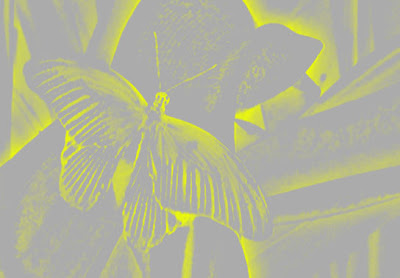Author Archive
Charcoal

When I was a teen and drawing, my two favorite media were pen and ink (the kind you actually had to fill the nib) and charcoal. I still have a framed drawing I gave my dad one year for Christmas, done in pen and ink. Not bad some 40-plus years later. Most of my charcoal is still in an old sketchpad.
I always used charcoal pencils where you could peel off some of the pencil layer and expose more charcoal. And now I own a bunch of pencils of different hardnesses for drawing. I haven’t gone back to pen and ink, although the new supplies now would be wonderful.
I am reminded of Janet at MMU who created some amazing calligraphers, before the calligraphy fonts were so popular. She really worked at the details for serif and sans serif, along with the many styles, and kids were picking up side work doing calligraphy for others. I did a couple of lessons with the kids, and good hand-calligraphy is an art in itself.
In introducing the kids to charcoal I had them do some shading by pencil to get the feel of the different types of shading. Then I gave them charcoal sticks (the boys all wanted to know if they would “light up.”) and showed them how to hold and use them. One of the most interesting things in this lesson was trying to convey pressure – light and heavy – for my English-language learners. Overall, not an easy thing to do!
Some of the kids really got into the charcoal, and a couple discovered the rubbing for shading on the different layers. Some didn’t like it at all – too messy, and they had trouble adjusting the amount of pressure.
A successful lesson for all, and now the kids have another tool they can use when it comes to shading for one of the next assignments.
Perspective, Part 2

The “dream rooms” as part of the perspective project have gone really well. I have learned so much from this assignment in how to kick my right brain into gear to break down art tasks into elements the kids can follow. Ironic, isn’t it, that since I am nearly done with art class I am figuring out how to actually teach it!
The use of the math vocabulary has been so extensive – I really had no idea just how much you use the vocabulary of math in art. If these kids don’t know “parallel” by now, they never will! It has been so interesting to see how parallel lines play such an important part in creating perspective drawings. I showed a few of the dream rooms to my eighth graders, and they really kicked the assignment into gear. I have found it also helps if I work at a table with a few of the kids, on my own drawing, and then answer questions and give suggestions.
This was really funny Thursday with some of my eighth grade boys. We had a great time – we were working on rooms together, and the “hard-core” guys were asking me to add stuff – like a Playboy Bunny logo on their full-ceiling plasma TV (hey, these are dream rooms) – so I sketched the logo – very lightly so that they would have to go over it and make it their own. You should have seen their eyes bug out when they realized I knew how to do that!
Next week I should be able to get pictures of rough drafts and their final copies – quite impressive, for a teacher who doesn’t have a clue!
That said, we started working with texture Friday. Again, thanks to a great website,
Intro to Art I had a good way to get the kids started. I worked up a PowerPoint on tonal, crosshatch, and linear textures, and made a worksheet with guidelines for them to follow. Then I had them repeat that exercise using charcoal…and that’s another story….
Makin’ T-Shirts

We are getting ready with our panels for the opening of our Contemporary Issues museum with my GATE class in May. Two of the girls want to do t-shirts about their project on landfills. One of the things with art class this time around has been having the paints out and available any time someone wants to use watercolors. Well, one day a few weeks ago they just started painting lots of water color about landfills. Friday they chose one and started to work on a t-shirt design. Here’s their original watercolor and their t-shirt one.
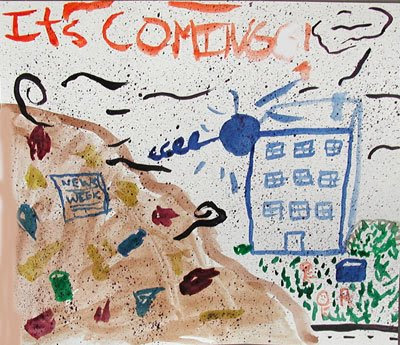
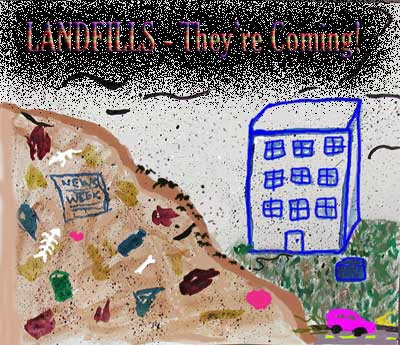
I anticipate a run on Photoshop as the rest of the class gets ready!
Illuminated Letters

I had a great time with the kids on Friday, taking pics of their letters, their mandalas, and in some cases, original work for their t-shirts for the upcoming museum. Remember, we also “aged” the paper to get a more realistic look. You will see some original letters, including a couple of students who went through several drafts before settling on their design. Most of the students opted to copy a letter, but I don’t think that detracted from the affective part of the assignment – taking care and really working at the letter until satisfied.
This first letter by Michael shows some incredible shading. Take a careful look at the inside of the M. He also worked to add a few extra flourishes on the bottom corner.
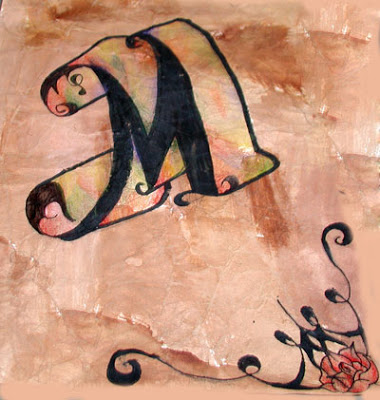
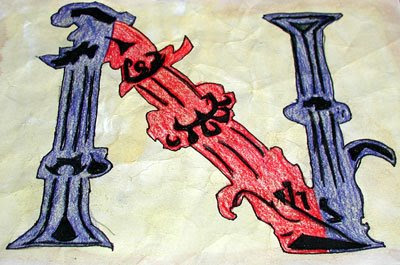
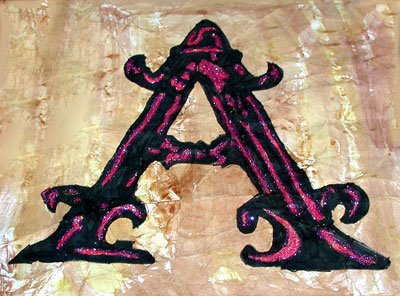
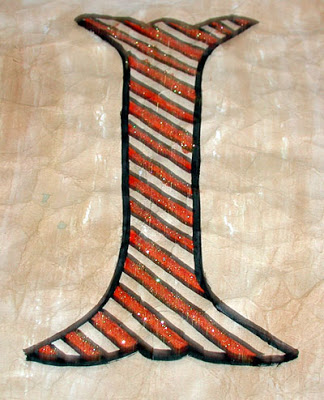

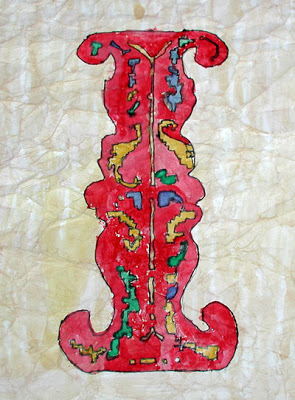
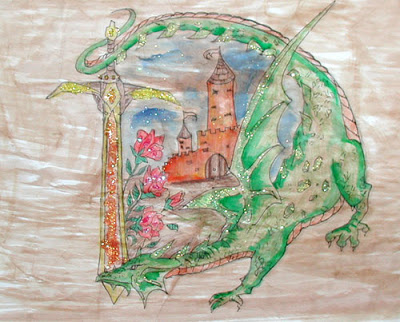
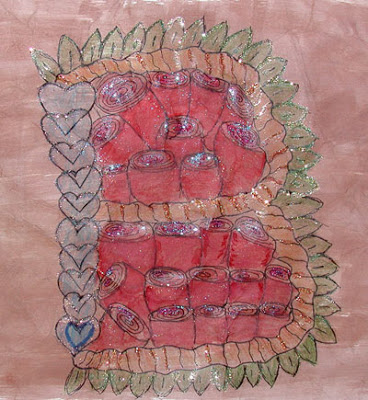
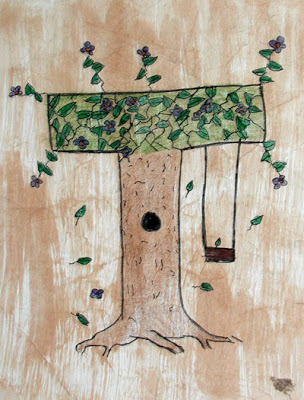


Teaching Perspective

I started an assignment on perspective last week, with really very little idea of how to teach this. I stumbled onto it by way of preparing a worksheet, since I had a substitute in my class on Monday, and I would need to have something for the kids to do. I found a site on line about perspective, and I really liked it. Drawing One-Point Perspective is a nice step-by-step for the kids. I printed out the “map grid” of lines and decided to do a worksheet for the kids, so that they could fill in the various lines. Turns out that was a great map, and the kids could now keep that as a “template” and create the furniture for their “dream room.”Most of the kids have really gotten in to creating fun stuff – with the help of this site, which actually takes them a line at a time.
What I was discovering was just how much math vocabulary we were working with. Vertical, horizontal, and parallel were definitely reinforced! And I am tempted now to try some drawing. Understanding the relationship of the lines to create depth is just fascinating – and I stumbled on a way of teaching it.
Artists’ Date

Julia Cameron in The Artist’s Way suggests taking a day each week to just enjoy art. Well, hubby and I did that today, as the weather will be mid-seventies. We went to the Tucson Botanical Gardens to see the butterflies.
We brought along the camera to get shots of plants, flowers, and of course the butterflies. We need to add to the shape library (and if I get good shots, I think I can turn them into shapes), as well as our own stock images to use with the digital marbling. We rambled through all the different gardens, marveling once again at how many different cactus there are – still amazing! Some of the wild flowers were spectacular, but nothing quite caught our breath like the butterflies!
Every now and then nature pulls one on you and you end up crying at the beauty. That’s was this was like. You walk into an enclosed rain forest-type environment and you are surrounded by butterflies all over the place – landing on you, in people’s hair, hiding in plants – absolutely beautiful.
So in honor of a gorgeous day, I am going to spend time on these pictures instead of doing lesson plans (that’s a whole ‘nother story….).
New Projects

I did remember the camera, but not until almost the end of art class. I snapped a few finished projects, but none of the “in progress.” The kids have started some serious work with embellishing their illuminated letters – those will be great pics. The next couple are from our color studies.

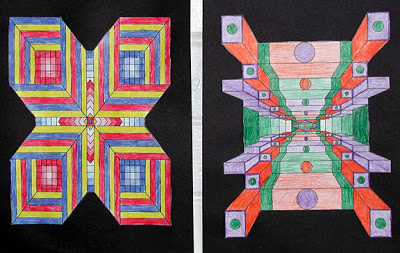
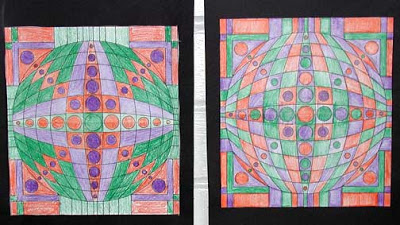
Each design (from a book on optical illusions) is either with the three primary or three secondary colors. They are arranged along one of the walls, and it is really interesting to see the variety among so many students. All the pieces had to have a line of symmetry, either horizontal or vertical, as a way of reinforcing math symmetry.
These next are some of our mandalas. The first is from my student artist who is amazing – he just draws whatever comes out of his head – I watch him in wonder! The second is from one of my girls who got really in to doing a series of lines inside each of her circles.
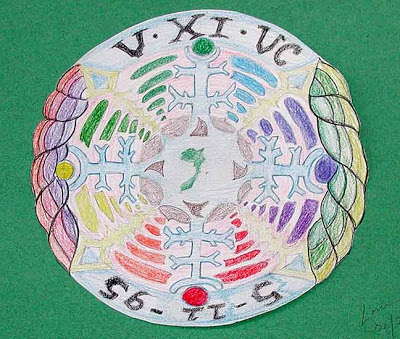
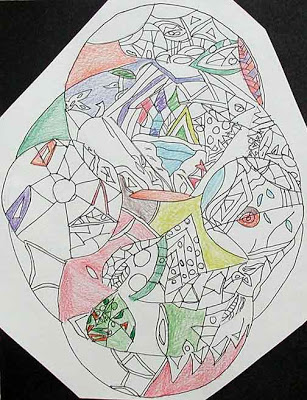
The next is from my young lady from last semester, now my aide, who has a nickname of Fudders (actually it’s Mother Fudders, but I made her clean it up for class). She loves Minnie!
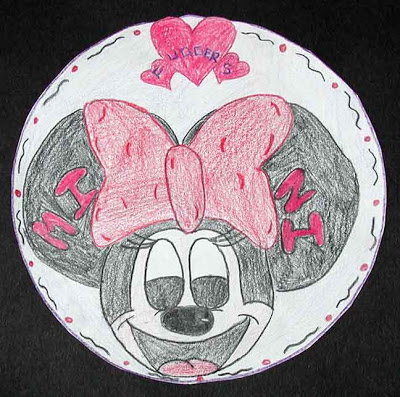
This next is the young man I was talking about in an earlier post – really well done.
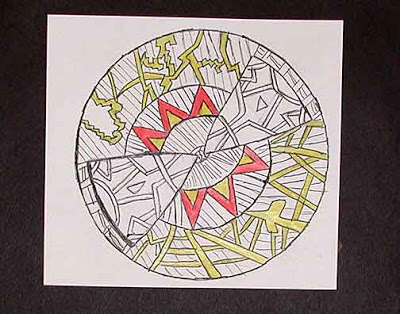
This next is one of my Somali girls who spent a huge amount of time on the lines. And another one with a lot of detail inside and very choosy on color.
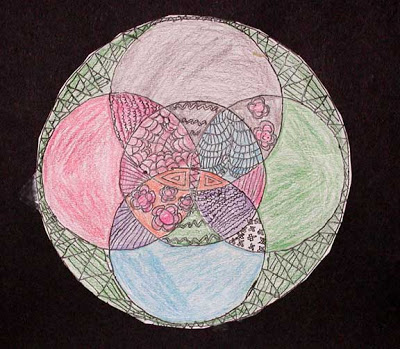
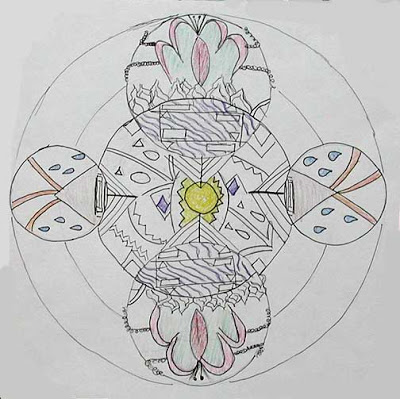
On Making "Parchment"

So I forgot the camera again today. A picture of me ironing paper would have been a priceless record of this art year. I got a recipe on line for making “parchment” paper – crumple up construction paper, smooth it out, do a water-color wash, and then when dry, iron it between newsprint.
It worked. Took a while to get the iron hot enough – I kept inching up the heat, because I had visions of setting a fire in the classroom. Took my time, and it really made a difference in the paper – made it stronger with all the moisture gone, and really made the paper look aged.
Then the kids really got into making copies from online of a medieval alphabet – traced with pencil and then used a thin black pen to outline it. They will start with color on Wednesday. Most of my eighth graders were walking around quite proud of their work.
Fabulous art site to show the kids next week – Chris Jordan – some very interesting environmental messages to his work. Click on his “Running the Numbers” – great blend of math and art!
Camera tomorrow – get it now and put it by the lunch bucket….camera….camera….camera….
When Art Class Works

There are times when art class just doesn’t work. For example, this past Monday. I had planned a time in the computer lab for the kids to browse a variety of sites and see some other potential areas of art they might like. One great site is the Frank Lloyd Wright Architect Studio 3D by the FLW Preservation Trust. This site takes the students on a tour of homes and information about the architect, but the best part of the site is the design studio, where kids can actually design a house. Sounds great, right?
Well, only if you are on a certain web browser, have updated computers, and have mice that work. Otherwise, you have 30 minutes of random clicking and shouts of “Miss, it’s not working.” By the end of the 90 minute period (and needless to say, no one had listened earlier to log-in instructions), I was so frustrated. Some kids stayed on the cartoon site the whole time (with some really great instructions for them), and some stayed on the Shadow Puppet site, building their own show (this is a fabulous site!). You can access my art class sites here.
I was both frustrated with the kids and with the computer lab. But on Wednesday the 8th grade class was wonderful – worked hard on mandalas and created and completed some great stuff. Thursday I started the illuminated letter project, with making “parchment” paper to start. After 45 minutes of no one listening to me, I took the kids out of the room and to my math class and proceeded to yell at them – which I never do. They had been horrible.
On Friday I tried the same assignment with my seventh grade, most of whom I have in math class. This is when it works…..
I was able to work with nearly evry student on some aspect of their art. I got all kids making the water color wash for their “parchment.” There were some great questions (can I use another blend?) and lots of creative ways of covering the paper. But the best part was helping the kids finish and mount their mandalas (I promise pictures soon). I would take their work and rotate the design, helping them to make decisions about orientation (not a word they knew). One student actually said, “You can do that?” I can so relate, because there were times when I thought the same thing.
The students were able to articulate which orientation they liked, explaining that it “moved” better. So I introduced the word “flow.”
Some students wanted to be creative in their framing – they wanted their circles kept whole on the white background, but wanted to play with the shape of the background construction paper. The biggest issue for me was trying to just suggest ideas, but still keep their work as the artist as much theirs as possible.
This really was a problem when it came to color. Some of the kids got very involved in the line drawings inside the circles that they had seen me do. They would occasionally moan about not being finished, but they also weren’t ready to quit until it was just the way they liked it. All designs were then gone over with a thin black marker – made the shapes really show, and also let the kids work with the idea of a draft.Then so many of them needed color.
I didn’t want to “instruct,” I wanted to lead. This was tough. I had some colors speak to me immediately, but I didn’t want to force anything. For one, he had some shapes that looked like arrows, and I suggested he look at just those – put his focus only on one area. What color would he like there? He chose red – just the color I was thinking of. So he did just those. We looked at it from a distance, and he decided he wanted to do the part on top in yellow to emphasize some of his lines. Looked fabulous. Then I suggested he do the same thing on the bottom, and introduced the idea of balance. When he finished, he looked at it again and pronounced it finished. He was happy with how it looked. (I would have added blue, but he’s the artist.)
Even better was the fact that I had several students who usually rush through assignments take three class periods to do their line work, and now they are just considering color. At the end, I was able to sit with one of my somewhat “energetic” group of boys and use their five entirely different mandalas to do a brief lesson in art critique.
That’s a class that works. The high from that 90 minutes will stay with me for several weeks.
New Directions

Last night I was working with one piece and came up with an incredible background (if I do say so myself). Sent it to Suzan, because I just couldn’t get the pot working, but I loved the background. One thing I am discovering is the need for a stronger story in the fabric, through shapes or other pictures. I don’t have much of a picture library, but Suzan managed to create some amazing stuff. The other thing I am discovering is the need for the fabric to show through as an integral part of the piece – so you can see the marbling background. Here’s the original background:

That said, here’s what Suzan did with the pot:

Certainly interesting, but this is where I realized I want to fabric design to be a stronger part of the piece.
Then Suzan did some mind-blowing manipulations:


And some even better stuff:


And finally, the piece de resistance….Marbled Canyon….

On Being Creative

It’s a nice, lazy Saturday, and I am cleaning and sorting, and generally playing with Photoshop. This time a year ago I was probably into week four of the first Photoshop class. What a difference a year makes! Thanks to MyJanee
I have been able to zoom with my Photoshop skills. Her courses gave me a strong set of basics, so when I started getting creative, I had already learned a lot.
There are a lot of questions now that need answers, now that Suzan and I have developed a body of work in digital marbling. I need to think about the website, and that needs to be done soon, as Eric Maisel’s blog writings are going to start happening in March, and I want our site ready for additional traffic.
Things to do:
1 – plan the new pages
2 – go back and review Cafe Press to see what has to be done for prints
3 – decide on framing possibilities
4 – decide on pricing of prints and originals
5 – continue to produce new work
6 – revise digital portfolio for submission to new galleries
7 – decide on some new galleries – anything available in Tucson?
That should keep us busy for a while.
Snowy Arizona….

It’s snowing up on the Rim, so we ended up having to cancel our trip north – which gave us more time to try some new work via email. The purple flowers from a few entries ago got Suzan’s expert advice, and now we have a new one –

Then I was playing with a new piece, trying to use a Native American pot shape. Great background, lots of possibilities. I was able to get some nice texture to the pot, but nothing really was happening overall.

I tried using some of the whispy brushes for the background.

Then I decided to just do away with the pot, added a gradient, and the background was amazing – very stormy, tornado spinning…..

More with Eric Maisel

As promised, here’s more with Eric Maisel, author of The Van Gogh Blues and creativity champion. I asked Eric a question concerning come of the frustrations I have been experiencing in teaching this year.
Me: I have come to see that for the immediate future my creativity is tied directly to my teaching middle school. I really work at making meaning when I am teaching, but I need some advice for my students. How do I help them make meaning? There is no light of learning in about 90 percent of them – they literally do not want to do the work – they will admit “I am lazy.” I always look beyond that to see what else might be going on (living out of a car, etc), but I really am stumped.This is a very low socio- economic area (I have never experienced poverty like this before in a school setting), and a failing school under No Child Left Behind. These kids have no record of school success for themselves – no sense of any intellectual meaning….
One of your comments (page 28, I think) is about how hard it is for professionals to stay away from depression, as opposed to interns and persons just starting out, since we have seen so much more. How do I help my kids?
Eric: I wonder if the answer, insofar as there is an answer, might not be in having (or allowing students to have) existential rather than curriculum-based discussions. What if students were asked to identify their most cherished values and to then try to imagine a life constructed around those values? Would they draw a blank, wax ironic, or find the task rich and useful? My hunch is that it is quite worth a try; one teacher reported to me that she engaged her third-graders (!) this way and that it make a remarkable difference in the way they self-regulated and tackled their work the whole school year. It would be grand to see meaning brought into the classroom—what could possibly be more important for students to think about and discuss?
I very much want to try more of this with my kids. I need to think about how to bring it in to the group, within the context o the classroom and the benefits of their education. Or maybe I just need to raise the issue of what is meaningful to them, and leave education completely out of the mix to start with. I would welcome comments and thoughts from you all!
Some other questions for Eric:
WHAT ADVICE DO YOU GIVE TO ARTISTS TO HANDLE THE POST-CREATION BLUES? The blues that happen when a project is done and you’ve worn yourself out.
Eric: Meaning must be made at all times or else we start to get those existential blues. But that isn’t to say that we can’t frame a day by the beach or a week incubating a project as meaningful time. The art is in our self-talk, where we consciously address our meaning needs by announcing where we want to invest meaning today: in a good rest, in a visit to the bookstore, in a little office organization, in a visit with a friend, and so on. What we want to guard against is the experience of meaninglessness that follows the completion of a project, and this we do by investing meaning wisely even though we may not have a new big project wanting to launch.
HOW CAN ARTISTS BEST FILL THE TIME IN PERIODS OF DORMANCY?
Eric: The answer revolves around how long the period of dormancy is and what the quality of that period is. If you tend to take three years off between projects, there is something going on there that needs to be addressed and you need to do a better job of forcing life to mean. If we’re taking about two weeks, that’s a very different matter. If it’s that shorter amount of time, then you can catch up on business matters (there is always something in that realm that needs doing), remind yourself why you love your art discipline by visiting a museum or reading a book, and passionately living your “parallel life,” that life of relationships and other meanings not connected to your creative projects.
ARTISTS OFTEN FACE CRITICISM IN THE FORM OF NOTES OR REVIEWS. HOW CAN AN ARTIST KEEP THEIR “SPIRIT UP” AND “FAITH IN THE WORK” IN THE FACE OF NEGATIVE FEEDBACK?
Eric: The first step is remember that everyone has an opinion, that great works have been roundly panned, and that you and you alone are the arbiter of meaning and quality in your life. If you don’t buy that at a visceral level, you will block when criticism comes. You have to have more than an intellectual understanding that your opinion must count the most: you must feel it in your bones. Once you possess that absolute certainty, then you can examine the criticism to see if there’s something there for you to learn—for often there is. The tricky dance is to reject all criticism while at the same time making use of feedback that serves you, a dance that no artist manages perfectly. Some err of the side of grandiosity and listen to no one; others, lacking in self-confidence, err in the direction of caving in and blocking.
SHOULD YOU FIGHT THE BLUES OR LET THEM COME?
Eric:It is my opinion that we should fight them, though not necessarily in the first five minutes or the first hour. Being in “that space” for a little while may be unavoidable and even necessary, but remaining in that painful place of inaction and despair has nothing really to recommend it. As soon as we can—and if we have gotten in the habit of disputing the blues, this will be sooner rather than later—we stand up tall, remind ourselves that we make the meaning in our life and that there is no meaning until we make it, and decide where we want to make our next meaning investment: in a new project, in the business of art, or in another sphere like relationships. If we can nip the blues in the bud before they even come by making that next meaning investment before meaninglessness even has a chance to rear its head, so much the better!
An Interview with Eric Maisel – Author of The Van Gogh Blues

Eric Maisel is a wonderful author, philosopher, and Renaissance man. Author of The Van Gogh Blues, he is stopping by today for an interview on creative people and depression. Sit back and enjoy!
Me: Eric, can you tell us what The Van Gogh Blues is about?
Eric: For more than 25 years I’ve been looking at the realities of the creative life and the make-up of the creative person in books like Fearless Creating, Creativity for Life, Coaching the Artist Within, and lots of others. A certain theme or idea began to emerge: that creative people are people who stand in relation to life in a certain way—they see themselves as active meaning-makers rather than as passive folks with no stake in the world and no inner potential to realize. This orientation makes meaning a certain kind of problem for them—if, in their own estimation, they aren’t making sufficient meaning, they get down. I began to see that this “simple” dynamic helped explain why so many creative people—I would say all of us at one time or another time—get the blues.
To say this more crisply, it seemed to me that the depression that we see in creative people was best conceptualized as existential depression, rather than as biological, psychological, or social depression. This meant that the treatment had to be existential in nature. You could medicate a depressed artist but you probably weren’t really getting at what was bothering him, namely that the meaning had leaked out of his life and that, as a result, he was just going through the motions, paralyzed by his meaning crisis.
Me: Are you saying that whenever a creative person is depressed, we are looking at existential depression? Or might that person be depressed in “some other way”?
Eric: When you’re depressed, especially if you are severely depressed, if the depression won’t go away, or if it comes back regularly, you owe it to yourself to get a medical work-up, because the cause might be biological and antidepressants might prove valuable. You also owe it to yourself to do some psychological work (hopefully with a sensible, talented, and effective therapist), as there may be psychological issues at play. But you ALSO owe it to yourself to explore whether the depression might be existential in nature and to see if your “treatment plan” should revolve around some key existential actions like reaffirming that your efforts matter and reinvesting meaning in your art and your life.
Me: So you’re saying that a person who decides, for whatever reason, that she is going to be a “meaning maker,” is more likely to get depressed by virtue of that very decision. In addition to telling herself that she matters and that her creative work matters, what else should she do to “keep meaning afloat” in her life? What else helps?
Eric: I think it is a great help just to have a “vocabulary of meaning” and to have language to use so that you know what is going on in your life. If you can’t accurately name a thing, it is very hard to think about that thing. That’s why I present a whole vocabulary of meaning in The Van Gogh Blues and introduce ideas and phrases like “meaning effort,” “meaning drain,” “meaning container,” and many others. When we get a rejection letter, we want to be able to say, “Oh, this is a meaning threat to my life as a novelist” and instantly reinvest meaning in our decision to write novels, because if we don’t think that way and speak that way, it is terribly easy to let that rejection letter precipitate a meaning crisis and get us seriously blue. By reminding ourselves that is our job not only to make meaning but also to maintain meaning when it is threatened, we get in the habit of remembering that we and we alone are in charge of keeping meaning afloat—no one else will do that for us. Having a vocabulary of meaning available to talk about these matters is a crucial part of the process.

Me: Could you explain more about the importance of creating a life plan sentence/statement?
Eric: If you agree to commit to active meaning-making, you need to know where to make your meaning investments, both in the short-term sense of knowing what to do with the next hour and in the long-term sense of knowing which novel you are writing or which career you’re pursuing. Having a life purpose statement or life plan statement in place serves as an ongoing reminder of the sorts of meaning investments that you intend to make, both short-term and long-term, and helps you make the right “meaning decision” about where to spend your capital and how to realize your potential.
Me: You list a number of core questions relating to creativity and making meaning in our lives. Do you feel that over time we will alternate between which question applies to us? Or is finding one question that applies to an artist is permanent, not changing over time?
Eric: There is no one question, just as there is no one meaning. The meaning-making process is a process of constant re-evaluation and ongoing analysis as we not only provide answers to our own questions but also provide ourselves with the right questions. For one period of time the questions may center on productivity, creativity, career, and the like, and during another period of time they may center on relationships, service, and the interpersonal sphere. Even on a single day, we might switch from asking ourselves one sort of question (about what project to tackle) to asking ourselves another sort of question (about how to help our addicted child or what to do about a community problem). Meaning shifts; so do the questions that we pose to ourselves about how to make and maintain meaning.
Me: What I hear you saying is that when creative people in particular maintain a connection to their mission or purpose (you call it a Life Purpose Statement in VGB), a connection to the value of their work, and their own value as creative people in the culture, they will be stronger in their work and in their lives. Is that a fair way to put it?
Eric: Yes. Even before you can make meaning, you must nominate yourself as the meaning-maker in your own life and fashion a central connection with yourself, one that is more aware, active, and purposeful than the connection most people fashion with themselves. Having some ideas about purpose is not the same as standing in relationship to yourself in such a way that you turn your ideas about purpose into concrete actions. Self-connection—understanding that you are your own advocate, taskmaster, coach, best friend, and sole arbiter of meaning and that no one else can or will serve those functions for you—is crucial.
Me: You mention that intimacy and personal relationships are as important to alleviating depression as are individual accomplishments. What is the link between the two and are they forged in similar ways?
Eric: It is important that we create and it is also important that we relate. Many artists have discovered that even though their creating feels supremely meaningful to them, creating alone does not alleviate depression. If it did, we would predict that productive and prolific creators would be spared depression, but we know that they have not been spared. More than creating is needed to fend off depression, because we have other meaning needs as well as the need to actualize our potential via creating. We also have the meaning need for human warmth, love, and intimacy: we find loving meaningful. Therefore we work on treating our existential depression in at least these two ways: by reminding ourselves that our creating matters and that therefore we must actively create; and by reminding ourselves that our relationships also matters, and that therefore we must actively relate.

Me: Do you think people creating in American culture have a more difficult time holding/making meaning for themselves and their work than creative workers in Europe, let’s say?
Eric: Yes. The very construction of European society, where people have more days off and more freedom to sit in a café and write, draw, dream, or chat, makes it easier for people to deeply consider how they what to represent themselves and how they want to make themselves proud. That is why European movies are “more meaningful” than American movies: our culture is dominated by the idea of happy endings and by clichéd and superficial examinations of the facts of existence. Because of our insidious pop culture, mass media, and bottom line-driven dynamics, it is harder for a creative person here to feel motivated to do the kind of meaningful work that is in his or her heart to do.
Me: Do you find any difference between creative media in how the process of losing meaning can happen? Do painters and writers or musicians and actors have a substantially different experience, or is the core of the experience the same?
Eric: There are many angles to this question, but let me focus on just two. Visual artists often produce one-of-a-kind products and have a hard time finding it meaningful that just one person will own that product, whereas writers can reach multiple “customers” with their creations. So the visual artist has to make personal sense of this issue and figure out how to let it “still be meaningful” that her painting may end up on the wall of a doctor’s waiting room or as one among many paintings in a collector’s back room. On an entirely different note, re-creative artists like actors and musicians often have to deal with the feeling that they are “only” serving the meaning needs of others—the composer, the screenwriter, the director—and often decide that they must also create as well as re-create: put on a one-woman show, put out an album of their own music, etc. These are just a few of the differences that arise among the different genres and disciplines.
Me: In Van Gogh Blues you mention some of the difficulties that can occur in creative communities when creators attempt to come together and connect with one another. You also refer to “marvels of relating,” a phrase I love. What are some steps we can take to improve our chances of giving and receiving these “marvels of relating” within creative community?
Eric: The most important internal movement is toward the belief that other people exist and that other people count. It is very easy to drift from taking sole responsibility for your meaning-making efforts, which is good thing, to a grandiose, arrogant, selfish, and narcissistic place where “only you count.” On the other side of the coin, if you grew up in an environment where the messages you received were about being seen and not heard, about blending in and not standing up for yourself, and so on, then you need to find the courage to stand up for yourself, to maintain healthy boundaries, and to exert your power as the meaning-maker of your own life. One artist may have as his central task treating others better; another artist may have as her central task standing up taller.
Me: You write about the difference between busyness and action. Could you give my readers a sample of the self-talk an artist needs to being thinking when she steps boldly into action?
Eric: The first step is to completely stop—not to slow down but to completely stop. Learning how to do this (and it isn’t easy, especially in our culture that promotes speed, fracture, and a short attention span) makes all the difference in a creative person’s life, as internal busyness is completely eliminated if in fact you actually stop, quiet your mind, and allow yourself to calmly grow present. The self-talk is exactly “I am completely stopping,” followed by the idea that you intend to calmly create without worrying about outcomes—that you are just intending to be present and to do your work. If a doubt or a worry intrudes, you dispute it by saying “I’m not interested in that doubt” or “I reject that worry,” return yourself to deep silence, and continue “just working.”
Me: When she feels the blues descending, what questions could an artist ask herself to locate the source of her discontent?
Eric: A medical work-up is a good idea, especially if her depressions in the past have been severe or long-lasting, as the coming depression might possibly be avoided with antidepressants (if it the “right” sort of depression). She can also engage in some simple “home remedies”: exercise is a depression-fighter, as is getting out in the sun. From an existential point of view, what she wants to ask herself is if her current creative work matters to her—if at some level it doesn’t, she will need to reinvest meaning in it by telling herself that she and it do matter; or, if she can’t imbue it with meaning, she will need to turn to other, more meaningful work.
Me: What might a person interested in these issues do to keep abreast of your work?
Eric: They might subscribe to my two podcast shows, The Joy of Living Creatively and Your Purpose-Centered Life, both on the Personal Life Media Network. You can find a show list for The Joy of Living Creatively here and one for Your Purpose-Centered Life here. They might also follow this tour, since each host on the tour will be asking his or her own special questions. Here is the complete tour schedule. If they are writers, they might be interested in my new book, A Writer’s Space, which appears this spring and in which I look at many existential issues in the lives of writers. They might also want to subscribe to my free newsletter, in which I preview a lot of the material that ends up in my books (and also keep folks abreast of my workshops and trainings). But of the course the most important thing is that they get their hands on The Van Gogh Blues!—since it is really likely to help them.
MORE TOMORROW! Some additional questions you might find interesting – and I will be writing for Eric’s creativity blog, starting in March. His work has been incredibly helpful.



